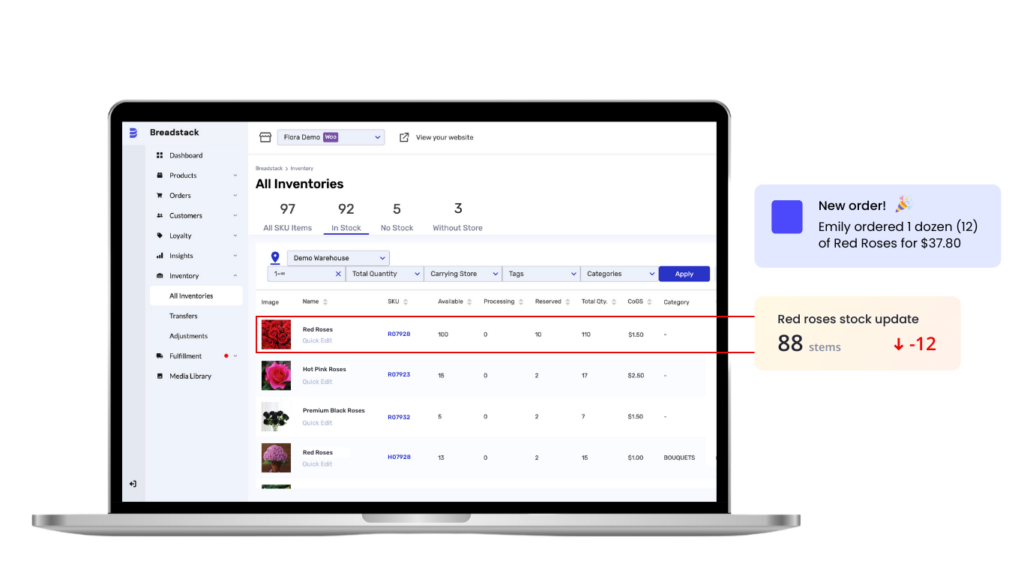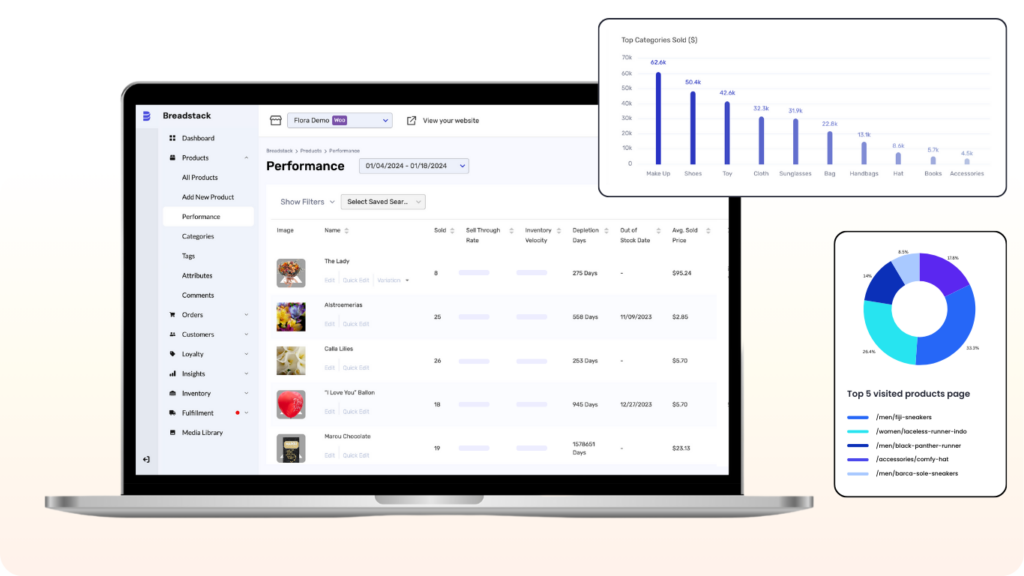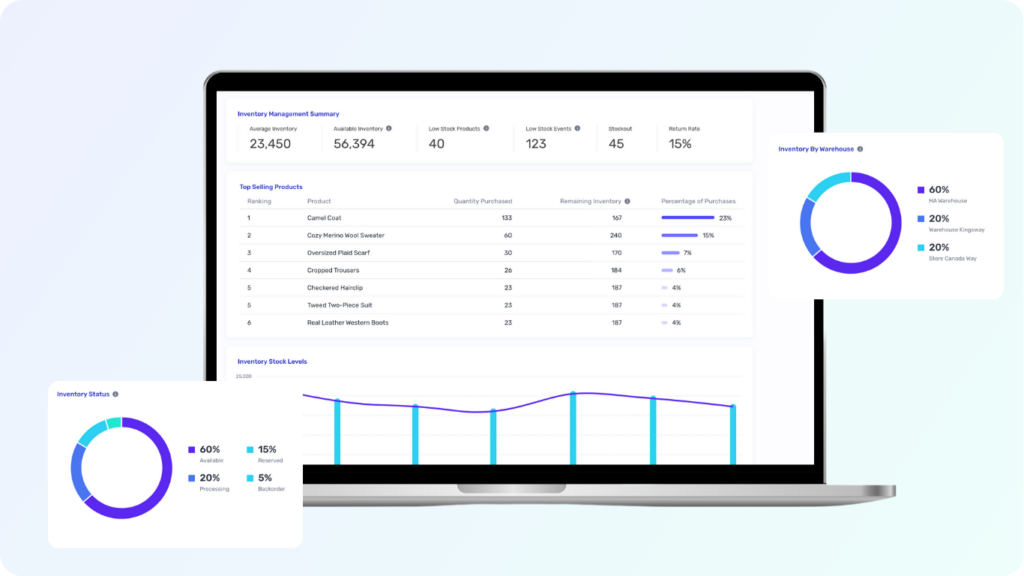It’s critical for organizations to stay current with effective methods in the business world of inventory management. The perpetual inventory system emerges as a game-changer, offering real-time tracking of stock levels.
This thorough manual explores the features, advantages, and implementation techniques of the perpetual inventory system, which is essential for maximizing inventory control in the competitive market of today.
What is a perpetual inventory system?
The perpetual inventory system is an automated method for tracking inventory that updates stock levels after each sale or purchase. It provides real-time insight into inventory levels, as opposed to periodic inventory systems, guaranteeing accurate and current stock information.
Unlike traditional periodic systems that require manual counting at specific intervals, perpetual inventory systems draw continuously on technology you already use, such as barcode scanners and point-of-sale systems, to automatically update inventory data with every transaction.

When a customer makes a purchase in a perpetual inventory system, the technology in place immediately captures and updates various data points. For example, let’s say a customer buys a product:
- Sale Recording
The point-of-sale system deducts the sold quantity from the inventory in real-time. - Data Update
The perpetual inventory system updates relevant information such as SKU, product description, and quantity available, ensuring accurate records. - Reorder Triggers
If the system is integrated with reorder point triggers, this purchase could automatically prompt the system to reorder more units of that product to maintain optimal stock levels. - Instant Visibility
Business owners instantly see the updated stock levels, providing a clear picture of what’s in stock and what needs replenishing.
How do retailers benefit from perpetual inventory systems?
Perpetual inventory systems take the guesswork out of stock management. At any given moment, you’ll know exactly what’s going on with your inventory – and automatic updates to all your systems mean there’s minimal risk of human error.
Here are just a few key ways businesses stand to benefit.
Boost sales and customer experience
The more accurate your view of your stock levels, the easier it is to order the right quantity of the right products at exactly the right moment.
If a certain product is having a surge of popularity and is at risk of selling out, you’ll know in real-time. You can confidently order more while the trend is still hot, rather than having to wait until your next stocktake, which could cause you to miss out.
On the flip side, nothing turns customers off more than placing an order for a much-anticipated product – only to be informed later on that the item was actually out of stock.
This can be an especially serious risk for retailers who operate multiple sales channels.Keeping inventory data coordinated across several platforms involves a huge potential for error.
Perpetual inventory systems keep all your data in sync, meaning you won’t have to worry about human oversight or gaps in technology causing inaccurate information on your site.
Stay compliant with industry regulations
In regulated industries like cannabis, perpetual inventory systems can help retailers stay compliant. Dispensaries face legal requirements that govern quantities and strains, along with restrictions on sales. Without airtight inventory management practices, the burden of ensuring compliance can quickly become a barrier to growth.
Access to real-time, accurate information on stock levels not only helps these retailers avoid transgressions; it also improves their transparency and accountability by enabling detailed record-keeping and accurate reporting.
With an enhanced ability to manage and track inventory, dispensaries can look forward to expansion without fear of facing fines or closures.
Manage finances efficiently and make better decisions
Perpetual inventory management streamlines financial reporting by providing real-time data. Your financial reports will become more accurate, and you’ll spend less time on manual tracking.
This kind of efficiency empowers businesses to make informed, data-driven decisions across various areas such as purchasing, Cost of Goods Sold (COGS), pricing, and sales strategies.

Not only does this foster stronger overall financial performance; it also allows you to make and implement decisions, such as adjusting inventory levels based on real-time demand, with more clarity and confidence.
Implementing a perpetual inventory system
Implementing a perpetual inventory system is an investment in the long-term health of your business. However, getting started can require navigating complex system relationships and paying close attention to the accuracy of your data.
This is a project worth doing well and seeing through. Inaccurate data entry or technical glitches can undermine your system’s effectiveness, leading to flawed decision-making. Meanwhile, implementing new technologies and staff training costs time and resources.
Solutions and Best Practices
With a bit of strategic planning, you can lay the groundwork for a successful perpetual inventory system. Here are a few elements to focus on when putting your strategy together:
- Comprehensive training
Ensure that staff is well-trained in using the new system to minimize data entry errors and maximize efficiency. Training programs should cover all aspects of the system’s functionality. - Data accuracy checks
Regularly audit and reconcile data to maintain accuracy. Automating alerts for discrepancies can help catch errors before they escalate. - Integration with existing systems
Choose systems that seamlessly integrate with existing software. APIs and middleware solutions can facilitate smooth connections with Point of Sale (POS) systems or other platforms. - Scalability considerations
Select a system that can scale with business growth. This ensures that your perpetual inventory system remains effective as your business expands. - Security measures
Implement robust security protocols to safeguard sensitive inventory and financial data. Encryption and access controls are critical for preventing unauthorized access.
By thoughtfully incorporating these points into your implementation strategy, you can unlock the full potential of perpetual inventory systems, enhancing accuracy, efficiency, and overall operational performance.
10 Steps to perpetual inventory management

Implementing a perpetual inventory system is a transformative process. It won’t happen overnight, but breaking it down into key phases can help you gain traction and avoid becoming overwhelmed.
Here are 10 key steps for a successful implementation.
1. Assess current processes
Conduct a thorough assessment of your existing inventory management processes. Identify pain points, areas for improvement, and the business needs you’re aiming to support.
2. Define system requirements
Based on your assessment, clearly outline the requirements and features you need in a perpetual inventory system. Consider aspects such as real-time tracking, integration capabilities, scalability, and user-friendly interfaces.
3. Choose the right software
Research and select your best-fit inventory management software solution. Ensure it aligns with your business’s size, industry, and growth goals. Look for user reviews, ask for recommendations, and consider software demonstrations.
4. Train your employees
Train staff on using the new system effectively. This may involve on-site training sessions, online tutorials, or workshops. Adequate training reduces the likelihood of errors and ensures a smooth transition.
5. Migrate your data
If transitioning from manual or another system, migrate existing data to the new system accurately. Data integrity is crucial for the success of a perpetual inventory system.
6. Integrate your systems
Integrate the perpetual inventory system with your other business systems, such as Point of Sale (POS) or Enterprise Resource Planning (ERP) systems. This ensures seamless data flow and reduces redundancy.
7. Set up real-time trackingIntegrate your systems
Configure the system to enable real-time inventory tracking of all stock movements. This includes sales, returns, and new stock arrivals. Automation minimizes the risk of human error and enhances the accuracy of data.
8. Establish security protocols
Implement robust security measures to protect sensitive inventory and financial data. This may involve encryption, access controls, and regular security audits.
9. Monitor and adjust
Continuously monitor system performance and user feedback. Make adjustments as needed to optimize processes and address any unforeseen issues.
10. Scale and expand
As your business grows, ensure the perpetual inventory system can scale along with it. Periodically reassess your needs and explore additional features that can further enhance operational efficiency.
Your way forward with inventory management
Increasingly, retailer industry analysts and business owners alike are viewing automated inventory tracking as a competitive advantage. By embracing the perpetual inventory system, you can unlock a more efficient, streamlined, and scalable approach to inventory management.
With so many retailers facing stock management challenges in recent years, it’s easy to see why strategic inventory management is so important. By transitioning away from labor-intensive, error-prone inventory checks to a perpetual inventory system, you can gain continuous visibility into stock levels. You’ll conserve resources while boosting sales and customer experiences through timely restocking decisions.
For industries like cannabis dispensaries, regulations don’t have to be a roadblock. Perpetual inventory systems can help you adhere to legal requirements, stay transparent, and keep detailed records.
Financially, perpetual inventory management streamlines operations and empowers businesses to make informed decisions across purchasing, COGS, pricing, and sales strategies. This efficiency not only fosters overall financial performance but also allows for better, faster-decision-making.
While implementing a perpetual inventory system requires careful planning, the benefits far outweigh the challenges. By following a structured approach and scaling the system with business growth, you can achieve sustained success in a fast-paced retail landscape.
